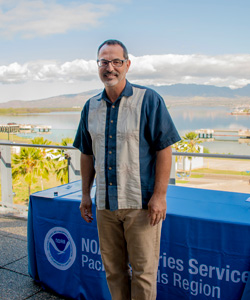Council Member Profiles
Former Reserve Advisory Council member profile

Michael D. Tosatto
2001 – 2005
"The integrity of ecosystem services in these terrestrial and aquatic environments are important for our national and Hawaiian cultural ethos. "
– Michael D. Tosatto, Regional Administrator, NOAA Fisheries, Pacific Islands Regional Office
Q: What drew you to participate in the NWHI Coral Reef Ecosystem Reserve Advisory Council?
A: My initial involvement was due to the potential law enforcement mission for the U.S. Coast Guard in the newly established Reserve. At the time, the establishment of MPA’s in ocean areas beyond the territorial sea were (and in many cases still are) controversial, so it was important for the USCG to participate from the very start. As I came to lead NOAA Fisheries in the region, my involvement continued as the many fisheries management issues were resolved.
Q: What are your personal thoughts on the place and why it deserves such dedicated protection?
A: I have patrolled these waters extensively in Coast Guard cutters, conducting law enforcement boardings, performing rescue missions and protecting the marine environment. The unique ecosystem is evident and worthy of protection.
Q: What do you see as the Reserve Advisory Council’s greatest achievement during the time you were directly involved?
A: Since my direct participation was in the early days, I’d have to say the greatest achievement is that a strong and cohesive body came together and has stood together for all these years.
Q: As a member of the council, what is one of your most memorable experiences?
A: Hosting what I think was the first in-person meeting of the RAC membership at the U.S. Coast Guard Club 14 on Sand Island. At least, it was my first opportunity to meet the ONMS staff and RAC membership. I remember saying “Hello” for the first time across the club parking lot or at the Club door, and in some cases, this has led to a two-decade partnership.
Q: What do you see as the biggest challenges facing the council and/or monument today?
A: Easy answer – Mother Nature. The changing world is impacting these areas. Man-made impacts on the land areas still need to be overcome and it is even more important now that the ongoing changes in ocean conditions along with episodic storm impacts are affecting the chances for survival of the green turtle and Hawaiian monk seal.
Q: Why should people care about protecting the monument?
A: We would be less if we lost the unique biodiversity and the natural, spiritual, and human history in the monument.


